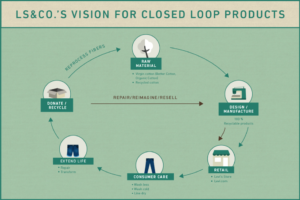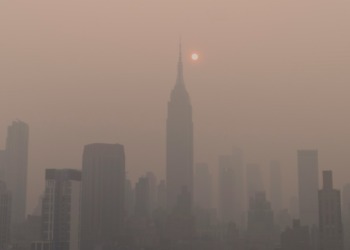Fifteen years after the Zero Waste Textile initiative started in San Francisco in 2003, the city has diverted 80 percent of all waste generated in the city away from landfill disposal through source reduction, reuse, recycling and composting programs—the highest rate of any major U.S. city according the Environmental Protection Agency. Although there is still a lot to go before reaching the goal of zero waste by 2030, there are clothing companies closing the loop between the production and recycling of our clothes.
For those uninitiated in the idea of a circular economy, “closing the gap” refers to the practice of designing, sourcing, producing, and providing clothes, shoes or accessories “with the intention to be used and circulate responsibly and effectively in society for as long as possible in their most valuable form, and hereafter return safely to the biosphere when no longer of human use.” In other words, it is the well-known mantra of reuse-reduce-recycle, just applied to our clothing.

Photo Credit LEVI STRAUSS & COMPANY
Some of the fast fashion chains like H&M and Levi Strauss, once accused of contributing to the city’s waste problem, partnered with San Francisco’s Department of the Environment with the commitment of making the Zero Waste Textile initiative a reality. Learn more about what they are doing to advocate for a more sustainable fashion industry below:
H&M: Bring It On
While H&M has become synonymous with “fast fashion” (almost infamously so), H&M is also quickly becoming sustainable fashion’s most vocal and staunchest supporters. Evidence of their commitment to the cause can be seen through their increasing use of recycled materials in their clothing production, which increased from 26 percent in 2016 to 35 percent in 2017. In total and in partnership with San Francisco’s Zero Textile Waste initiative, they have collected almost 18,000 tonnes of textiles through its own garment collecting initiative in the past year, which is the equivalent of 89 million T-shirts.
Looking forward, H&M is also making strides for a more equitable workplace in addition to an environmentally friendly fashion industry. In 2018, 100 percent of their garment manufacturer units in Bangladesh conducted democratic elections of worker representatives, and out of the 2,882 persons were elected, 40 percent were women. Furthermore, H&M has pledged to use all recycled or sustainably sourced materials by 2030, setting an annual collection target of 25,000 tonnes of disposed clothes.
The North Face: Clothes the Loop
https://www.youtube.com/watch?v=cPAH95wCEas
The North Face, another partner in the Zero Textile Waste initiative, is also joining the fight against clothing waste with the not so subtle pun of their “Clothes the Loop” project that aims to, as the project is so aptly named, close the loop between garment being discarded and repurposed. Since the Clothes the Loop started in 2013, The North Face has collected more than 95,000 pounds of clothing and footwear.
In addition to helping reduce the rate at which clothes end up in our landfills, The North Face also is committed to increasing sustainability in other areas, such as jobs security and the environment. They partnered up with a non-profit called Soles4Souls whose mission is to create sustainable jobs and provide relief through the distribution of shoes and clothing. Ultimately, the clothing recycled through Clothes the Loop are repurposed for disaster relief or micro-enterprise programs that aim to provide small entrepreneurs with business opportunities.
Related Articles:
![]() “SLOW FASHION, ETHICAL FASHION” by Angela Bell
“SLOW FASHION, ETHICAL FASHION” by Angela Bell
![]() “FASHION ‘SLOWDOWN’ MISSION” by Jessica Saade
“FASHION ‘SLOWDOWN’ MISSION” by Jessica Saade
The North Face is also partners with The Conservation Alliance, which funds community-based campaigns to protect wilderness and recreation areas in local communities. Their commitment to protecting public lands has enabled them to help protect 45 million acres, 2,972 river miles, removed or halted 28 dams, purchased 11 climbing areas, and designated 5 marine reserves—including the California coastline.
Levi Strauss & Company: Progress With Less
Known for being a mainstay and icon of denim wear, Levi Strauss & Company is also making moves to be recognized as leaders in fashion recycling with the Progress With Less program. San Francisco annually sends almost 20,000 tonnes of textiles to landfills. That’s 4,587 pounds every hour and more than 39 million pounds a year. Textiles are among the top three materials that San Franciscans send to landfills. With the Progress With Less program in coordination with the city’s Zero Textile Waste initiative, Levi’s is working to ensure that the raw materials from the items collected in their stores are put to new use.
The city will protect the environment, generate economic growth, further solidify San Francisco as the ‘greenest city in North America,’ and lead and inspire communities, businesses and other cities around the globe.
One extraordinary way Levi’s is truly exemplifying giving garments new life can been seen at their headquarters in San Francisco—they are insulated with more than 25,500 pairs of recycled jeans. They are also working with other local organizations in the city to bring recycled denim insulation to their buildings. Levi’s is one of the Zero Textile Waste intiative’s leading partners and was particularly invested in the cause, stating that “the city will protect the environment, generate economic growth, further solidify San Francisco as the ‘greenest city in North America,’ and lead and inspire communities, businesses and other cities around the globe.”









